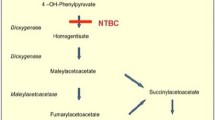Abstract
A 25-year-old woman with tyrosinaemia type II was treated from the 5th week of pregnancy with a protein-restricted diet supplemented with a tyrosine/phenylalanine-free amino acid mixture. Tyrosine concentrations were maintained in the range 100–200 μmol/l by restricting natural protein intake to 0.16 g/kg per 24h in early pregnancy, with increases up to 0.38 g/kg per 24h in the last trimester. This treatment maintained plasma phenylalanine concentrations in the range 20–40 μmol/l. Maternal weight gain and fetal growth were normal, and the mother remained asymptomatic throughout the pregnancy. A normal infant was born at term with length, weight and head circumference between the 25–50 th per centiles.
Similar content being viewed by others
Abbreviations
- PKU:
-
phenylketonuria
References
Arevalo R, Castro R, Palarea MD, Rodriguez M (1987) Tyrosine administration to pregnant rats induces persistent behavioural modifications in the male offspring. Physiol Behav 39:477–481
Arn PH, Hauser ER, Thomas GH, Herman G, Hess D, Brusilow SW (1990) Hyperammonemia in women with a mutation at the ornithine carbamoyltransferase locus: A cause of postpartum coma. N Engl J Med 322:1652–1655
Brenton DP (1988) Maternal phenylketonuria. Eur J Clin Nutr 43:13–17
Brenton DP, Haseler ME (1990) Maternal phenylketonuria. In: Fernandes J, Saudubray J-M, Tada K (eds) Inborn metabolic diseases. Diagnosis and treatment. Springer, Berlin Heidelberg New York, pp 175–182
Cockburn F, Robins SP, Forfar JO (1970) Free amino-acid concentrations in fetal fluids. BMJ 3:747–750
Dreosti IE (1989) Recommended dietary intake for protein in Australia. Aust J Nutr Dieterics 46:82–92
Drogari E, Smith I, Beasley M, Lloyd JK (1987) Timing of strict diet in relation to fetal damage in maternal phenylketonuria. Lancet II:927–930
Faull KF, Gan I, Halpern B, Hammond J, Im S, Cotton RGH, Danks DM, Freeman R (1977) Metabolic studies on two patients with nonhepatic tyrosinemia using deuterated tyrosine loads. Pediatr Res 11:631–637
Fois A, Borgogni P, Cioni M, Molinelli M, Frezzotti R, Bardelli AM, Lasorella G, Barberi L, Durand P, DiRocco M, Romano C, Parini R, Corbetta C, Giovannini M, Riva E, Balato N, Sartorio R, Mollica F, Zammarchi E, Battini ML (1986) Presentation of the data of the Italian Registry of Oculocutaneous Tyrosinaemia. J Inherited Metab Dis 9 [Suppl 2]:262–264
Garabal MV, Arevalo RM, Diaz-Palarea MD, Castro R, Rodriguez M (1988) Tyrosine availability and brain noradrenaline synthesis in the fetus: Control by maternal tyrosine ingestion. Brain Res 457:330–337
Gipson IK, Burns RP, Wolfe-Lande JD (1975) Crystals in corneal epithelial lesions of tyrosine fed rats. Invest Ophthalmol 14:937–941
Goldsmith LA (1978) Molecular biology and molecular pathology of a newly described molecular disease—tyrosinemia II. Exp Cell Biol 46:96–113
Goldsmith LA (1978) Tyrosine-induced skin disease. Br J Dermatol 98:119–123
Goldsmith LA, Laberge C (1989) Tyrosinemia and related disorders. In: Scriver CR, Beaudet AL, Sly WS, Valle D (eds) The metabolic basis of inherited disease, 6th edn. McGraw-Hill, New York, pp 547–562
Huether G (1989) Amino acid availability and brain development: effects of nutritional and metabolic inadequacies. Eur J Clin Nutr 43:19–25
Hyanek J, Homolka J, Trnka J, Seemanova E, Cervenka J, Tresohlava Z, Kapras J, Dolezal A, Sracek J, Vacha V, Hoza J, Losan F, Nevsimalova S, Mala M, Viletova H (1979) Results of screening for phenylalanine and other amino acid disturbances among pregnant women. J Inherited Metab Dis 2:59–63
Levy H, Lenke R, Koch R (1984) Lack of fetal effect on blood phenylalanine concentration in maternal PKU. J Pediatr 104:245–247
Lewis SA, Lyon ICT, Elliott RB (1985) Outcome of pregnancy in the rat with mild hyperphenylalaninaemia and hypertyrosinaemia: Implications for the management of “Human maternal PKU”. J Inherited Metab Dis 8:113–117
Lou HC, Guttler F, Lykkelund C, Bruhn P, Niederwieser A (1985) Decreased vigilance and neurotransmitter synthesis after discontinuation of dietary treatment for PKU in adolescents. Eur J Pediatr 144:17–20
Pratt OE (1982) Transport inhibition in the pathology of phenylketonuria and other inherited metabolic diseases. J Inherited Metab Dis 5 [Suppl 2]:75–81
Rice DN, Houston IB, Lyon ICT, MacArthur BA, Mullins PR, Veale AMO, Guthrie R (1983) Transient neonatal tyrosinaemia in neonatal screening. Experta Medica Int Congr Series 606:306–310
Rohde W, Ohkawa T, Gotz F, Stahl F, Tonjes R, Takeshita S, Kambegawa S, Kambegawa A, Arai K, Okinaga S (1989) Sex-specific effects on the fetal neuroendocrine system during acute stress in late pregnancy of rat and the influence of a simultaneous treatment by tyrosine. Exp Clin Endocrinol 94:23–42
Soltesz G, Harris D, MacKenzie IZ, Aynsley-Green A (1985) The metabolic and endocrine milieu of the human fetus and mother at 18–21 weeks of gestation. I. Plasma amino acids concentrations. Pediatr Res 19:91–93
Truswell SA (1990) Recommended nutrient intakes—Australian papers. Australian Professional Publications, Sydney
Warwick PM (1989) Predicting food energy requirements for estimates of energy expenditure. Aust J Nutr Dieterics 46 [Suppl]:S3-S28
Author information
Authors and Affiliations
Rights and permissions
About this article
Cite this article
Francis, D.E.M., Kirby, D.M. & Thompson, G.N. Maternal tyrosinaemia II: Management and successful outcome. Eur J Pediatr 151, 196–199 (1992). https://doi.org/10.1007/BF01954383
Issue Date:
DOI: https://doi.org/10.1007/BF01954383




